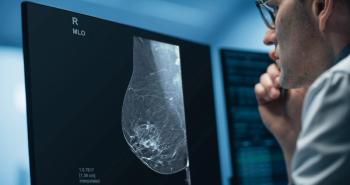
Digital mammography delivers rapid results
Use of digital mammography is routine practice at Allegheny General Hospital in Pittsburgh, although the breast imaging team, headed by Dr. William Poller, is still smoothing out the kinks.
Use of digital mammography is routine practice at Allegheny General Hospital in Pittsburgh, although the breast imaging team, headed by Dr. William Poller, is still smoothing out the kinks.
The benefits that have evolved since the hospital installed four GE full-field units three years ago include increased technologist productivity and the ability to deliver results to patients within minutes.
"Our technologists and screening patients love it, because they are going through much faster," Poller said. "We made the decision early on to look at every case, screening and diagnostic, before the patient leaves. They are thrilled that they are getting the answer right away."
Poller, who offered tips on integrating digital mammography in an article for Diagnostic Imaging ("Digital mammography center streamlines screening process," November 2003, page 55), described how use of digital technology at Allegheny has progressed.
The few downsides that exist relate to how the new modality affects workflow, he said, but these issues are being addressed.
For example, it can take radiologists several months to become completely comfortable with the full-field digital concept. When digital systems were first installed, printed digital images were hung alongside prior screen-film images to make comparisons easier. Over time, radiologists mastered onscreen image interpretation and manipulation of digital images, from changing window widths and level to zooming in on and annotating images.
Although the prior screening studies of most Allegheny patients are now in digital form, an alternator is still needed in the reading room for films referred from other sites.
Redesigning the department so that all radiologists have their own reading area was the biggest step toward a successful digital transition, Poller said. Preferably, each reading area should be equipped with adequate air ventilation and dimmed lighting.
Poller works in a separate reading room at Allegheny, with two additional workstations sited in an adjacent room.
"If you have more than one workstation in a room with two alternators, it's still not good sometimes," he said. "The other alternator may be on, and you are reading digital images and asking your colleague to dim the lights."
One of the surprising challenges in shifting to digital mammography was the difficulty in comparing current digital images with prior ones. The soft-copy workstations now in use do not allow radiologists to choose images from a specific year; instead, the system automatically selects the most recent year for comparisons.
"But you might want to look at the study that is two years old instead of the most recent study first," Poller said. "If there is nothing there, then you are done. But the workstation is not designed to allow that."
The issue is not unique to GE workstations, although that vendor has designed new software, to be installed this month, that will address the problem, Poller said.
CLINICAL ISSUES
While much progress has been made in terms of design and workflow, other issues remain. Patient flow, for example: Deciding which patients will receive digital mammography and which ones will undergo standard film-based screening continues to be a challenge, Poller said. With the GE unit, breast size is the major factor in this consideration.
"We are a little unusual in how we handle these patients," he said. "I will not do a case if I have to piece together a patient. If a woman comes in who needs a 24 x 30-inch plate, we are going to use screen-film. That's just me. It's not right or wrong."
The policy doesn't include cleavage views, which Poller routinely acquires with the digital unit when needed. But it does apply to women with large breasts that may not entirely fit on the imaging plate. The problem is unique to GE, he said.
"You can imagine that if you are piecing together images, and you are reviewing images from several years, you are going to have multiple images," he said.
Allegheny is one of 35 sites across the U.S. that participated in the Digital Mammography Imaging Screening Trial (DMIST), a study involving 49,500 women that compared the clinical accuracy of film and digital mammography screening. Results of the study were expected this spring. Poller declined to predict what the study might show but did indicate a preference for digital images when examining women with dense breasts.
"I can only speak anecdotally, but if I'm looking at a dense breast, I am more comfortable looking at a digital image," Poller said. "Whether it's a true feeling or not, I don't know."
A few cancers have turned up within the population of women participating in DMIST who have now returned for their annual screening exam, he said. But a review of both the film and digital images in these patients from the year before revealed no findings.
"We are going to get an answer on DMIST soon," he said. "But I don't think, in terms of quality, it is going to be significant one way or the other. Regardless, it appears that digital is moving, maybe not as fast as the vendors would like. But people are getting on board."
Ms. Dakins is feature editor of Diagnostic Imaging.
Newsletter
Stay at the forefront of radiology with the Diagnostic Imaging newsletter, delivering the latest news, clinical insights, and imaging advancements for today’s radiologists.




























